| Srl | Item |
| 1 |
ID:
129532
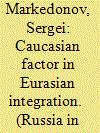

|
|
|
|
|
| Publication |
2014.
|
| Summary/Abstract |
Moscow has made the largest progress in Eurasian integration with Armenia. It has had no integration plans (given numerous constraints) with regard to Azerbaijan or Georgia. Yet Russia's victory cannot be regarded complete or unequivocal. Eurasian integration is one of Russia's key foreign policy priorities at present, viewed as an instrument to bolster its influence in the international arena. As President Vladimir Putin said, "We propose a model of a powerful, supranational union, capable of becoming one of the poles of the modern world and playing an effective role in linking Europe to the thriving Asia-Pacific region."
Prospects for a major reconfiguration of the post-Soviet space emerged after the Customs Union agreement became effective in July 2010. It was followed by three-and-half-years efforts by Russia and its closest partners Belarus and Kazakhstan to institutionalize the Eurasian integration project, which opened the possibility of other former Soviet republics joining the core "union of three
|
|
|
|
|
|
|
|
|
|
|
|
|
|
|
|
| 2 |
ID:
134115
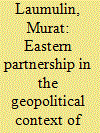

|
|
|
|
|
| Publication |
2014.
|
| Summary/Abstract |
The Eastern Partnership (EP) program should be viewed as another attempt to reformat the post-Soviet space along anti-Russian and anti-Eurasian lines and a response to Moscow's integration activities. This is not the first attempt of its kind: the West has already tried other geopolitical and geoeconomic tools. The final aim, however, has remained the same: Russia's domination and possible integration of post-Soviet regions irrespective of form, even economically adequate, should be prevented by all means.
|
|
|
|
|
|
|
|
|
|
|
|
|
|
|
|
| 3 |
ID:
138058
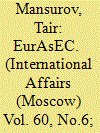

|
|
|
|
|
| Summary/Abstract |
INTEGRATION PROCESSES are a qualitatively new form of interaction between states in the modern world based on the establishment of a common framework for the operation of production factors and a single system for managing the common space, including a supranational component.The goals of integration are usually the same for all regional integration models, but in each particular case they have different motivations and are based on different approaches. The diversity of socio-economic, geographic, geopolitical, historical and cultural conditions generates numerous forms of integration, each of which is unique. The process of international integration as we know it today began in the mid-20th century, so that sufficient theoretical and practical experience has been gained throughout the world in this area.
|
|
|
|
|
|
|
|
|
|
|
|
|
|
|
|
| 4 |
ID:
137285


|
|
|
|
|
| Summary/Abstract |
THE GEOPOLITICAL BALANCE of the latter half of the 20th century was tipped in the early 1990s by the Soviet Union's disintegration which buried the bipolar world order. There is a more or less common opinion that we are entering a Cold Peace era in which Russia might be pushed aside.
|
|
|
|
|
|
|
|
|
|
|
|
|
|
|
|
| 5 |
ID:
138052


|
|
|
|
|
| Summary/Abstract |
SUSTAINABLE DEVELOPMENT for market economy countries presupposes the formation of country integration groups based on the mutual adaptability of national economies. The objective prerequisite for such action is the existence of a Single Economic Space (SES) provided by political, legal, informational and institutional measures.1 As a trend in the development of the system of international relations, the integration process goes in its evolution through certain stages. With respect to the Eurasian integration, we can view these steps from the perspective of the implementation of the political agreements made by leaders of the CIS countries.
|
|
|
|
|
|
|
|
|
|
|
|
|
|
|
|
| 6 |
ID:
137328
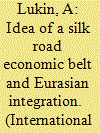

|
|
|
|
|
| Summary/Abstract |
IN A SPEECH at Nazarbayev University in Astana on September 7, 2013. President Xi Jinping of the People's Republic of China (PRC) proposed the idea of building an economic belt along the Silk Road as a new form of enhancing cooperation between China, the Central Asian states and Russia. Various aspects of this idea have become a topic of heated debate in China and other countries. In order to identify the new elements of this concept and understand its role in the contest of ideas and projects associated with Central Asia, we must take a brief look at the history of this issue.
|
|
|
|
|
|
|
|
|
|
|
|
|
|
|
|
| 7 |
ID:
192434


|
|
|
|
|
| Summary/Abstract |
POVERTY has been and remains a key global problem, including for the states of Central Asia (CA). For the world's economies, this phenomenon is often associated with systemic problems in various fields - from the need for political modernization to the real sector of the economy. It is fair to say that the systemic nature of poverty causes a number of problems: low education levels, forced migration due to unemployment, etc. At the same time, Central Asia's integration into global economic chains remains weak.
|
|
|
|
|
|
|
|
|
|
|
|
|
|
|
|
| 8 |
ID:
160897


|
|
|
|
|
| Summary/Abstract |
The contours of regionalism in a wider Europe are shaped by two dominant actors, the European Union (EU) and Russia, which often have divergent visions of the regional landscapes in a vast area constituting their common neighbourhood. The EU can be characterised as the promoter of normative regionalism, while Russia generates different forms of civilisational regionalism. Russia’s emphasis on the civilisational underpinnings of its regional integration model paves the way for two different strategies: one based on liberal imitation and replication of EU experiences in order to strengthen Russia’s position in the global neoliberal economy, and another grounded in illiberal contestation of the normative premises of the EU with the purpose of devising an ideologised alternative to the liberal West.
|
|
|
|
|
|
|
|
|
|
|
|
|
|
|
|
| 9 |
ID:
146298
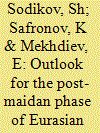

|
|
|
|
|
| Summary/Abstract |
EXPERTS increasingly often use maidan, the Persian for "open field," as the key word in describing today's geopolitical situation in Eurasia. The conflict in Ukraine has affected the geopolitical configurations in Central Asia, and has created new obstacles and challenges to the Eurasian integration project, a large-scale plan to build an economic alliance of Russia and several other former Soviet republics.
|
|
|
|
|
|
|
|
|
|
|
|
|
|
|
|
| 10 |
ID:
130901


|
|
|
|
|
| Publication |
2014.
|
| Summary/Abstract |
IRRESPECTIVE of Ukraine's future status - either associated with or integrated in the EU or left to itself in the grey zone between the two giants - the European Union and the emerging Eurasian Union, its failure to join the Eurasian Union will represent a serious challenge. This threatens the country's economic security and the common Russian identity of its population; it is a challenge to the historical unity of Russia and the Russian World and their cultural, linguistic and geopolitical integrity. We cannot succumb to this challenge; we should confront it and find the way and means to defuse it.
|
|
|
|
|
|
|
|
|
|
|
|
|
|
|
|